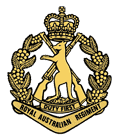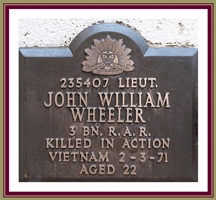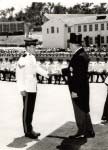|
3rd Battalion Royal Australian Regiment
Your FaithfullyJapan - Korea - Malaya - Borneo - Vietnam - East Timor - Solomons - Iraq - Afghanistan |
| 3rd Battalion Royal Australian Regiment |
||||||||||||||||||||||||||||||||||||||||||||||||||||
 |
||||||||||||||||||||||||||||||||||||||||||||||||||||
| Roll of Honour |
||||||||||||||||||||||||||||||||||||||||||||||||||||
| Lt. John William Wheeler KIA 2nd March 1971 |
||||||||||||||||||||||||||||||||||||||||||||||||||||
John was keen to pursue a career in the Army, and was accepted into the Royal Military College, Duntroon in January 1966. He graduated in December 1969, and was allocated to the Infantry Corps, with the rank of Lieutenant. In January 1970 John was posted to the 3rd Battalion, Royal Australian Regiment, based in Woodside, South Australia. In 1970 the Battalion was preparing for a second tour of Vietnam. John assumed command of 10 Platoon, D Company and spent that year training and readying his platoon for active service. The 3rd Battalion arrived in Vietnam at the end of February 1971, and began familiarisation operations, in an area of supposed low enemy activity. That turned out not to be the case. On the night of 2 March 1971, the rifle Companies of the Battalion took up defensive positions east of the Australian base in Nui Dat. Later that night, D Company came under attack by a Viet Cong force. John was moving between defensive positions, supporting and encouraging the men of 10 Platoon, when he was killed in a large explosion. Private Paul Manning was also killed that night, and Privates Strickland and Hammond were seriously wounded. John Wheeler was 22 years old when he died. He was survived by his parents, and by his brother David and his sisters, Ruth and Louise. The remains of Lieutenant John William Wheeler rest in this place, Norwood Park Crematorium. A Memorial Plaque is installed at Lyneham High School, Goodwin Street, Lyneham ACT Lt John William Wheeler is inscribed on the Roll Of Honour at the Australian War Memorial, among the more than 500 Australian servicemen who died while serving in the Vietnam War. |
||||||||||||||||||||||||||||||||||||||||||||||||||||
Australian War Memorial |
||||||||||||||||||||||||||||||||||||||||||||||||||||
| Grave Side Service Lt John William Wheeler 3rd Battalion RAR Vietnam 1971 50th Anniversary Reunion and the Commemoration of Operation Overlord and the Battle of Long Khanh. Norwood Park Crematorium (ACT), Saturday 5th June 2021 Download: Graveside Service Program |
||||||||||||||||||||||||||||||||||||||||||||||||||||
Lt. John William Wheeler John W. Wheeler, 22, Cremorne, NSW |
||||||||||||||||||||||||||||||||||||||||||||||||||||
Everyone Had a Long Night The 4 Infantry Companies (A, B, C & D) had been deployed from Nui Dat on the 27th February, just two days after arriving in Vietnam. The “in theatre" operational training had commenced allowing all soldiers to familiarise with the duties expected of them in a theatre of war. Up to this point the climate and the work load had, I am sure, exhausted everyone. It was now the evening of the 2nd March. Contact with the enemy, presumed to be VC, had been reported by various elements of 3RAR during the day. Later in the afternoon, the Charlie (C) Company, 3 RAR Platoon Commanders were ordered by Company Commander (OC) to Harbour in a Company position a short distance away from Delta (D) Company in dry, scrubby country dotted with patches of bamboo and tall trees. From memory, the Harbour went in quickly and without too much fuss considering it was a sizeable manoeuvre practiced only once or twice before in Australia. The 3 Platoons (7, 8 & 9) linked on the circular defensive perimeter, back to each Platoon headquarters located in depth, and then to Company HQ in the centre of the large circle. We had on this night 3 Centurion tanks join the Harbour and one of these tanks was located out on the 9 Platoon perimeter. There was no moon and the night was pitch black. The multi company night Harbour of approximately 250 men had “gone in” efficiently and quietly extending over a large (now defended) area. After the evening routine of placing gun picquets and other infantry duties had finished, a heavy contact was initiated with Delta Company nearby. Charlie Company immediately stood to as is the practice. The essential task was to keep alert for the enemy who were moving onto our position and to keep rules of engagement foremost in our minds. Firing at night could cause havoc among friend-lies as well as the enemy. I remember thinking at the height of the battle several hundred meters away how terrifying all this really was - with gun ships, artillery, mortars, flares and tanks all firing - but, how calmly and efficiently everyone was going about his business preparing to defend the Company perimeter. The artillery flares with their ghostly shadows among the undergrowth added to the spectacle. Word soon came through over the radio network that "Snow" Strickland had been severely wounded and several others badly hurt as well. About the same time, we heard the news that Pte Paul Manning and Lt. Johnny Wheeler had both been killed. The RAAF dust off was unable to come in for the priority wounded because the Landing Zone was not secure. An American medivac helicopter en route from Vung Tau to Long Dien saw and heard the Delta Company contact activity and offered to assist. The pilot directed in, under fire, over the Delta Company position and, apart from calmly keeping in touch with the boys on the ground who were hooking up "Snow" and the others in the dark, he only once asked without a tremor, "Hey you guys, can ya hurry up!!". The helicopter was receiving ground fire with the helicopter's blades swinging just millimeters over the tops of the trees, but he and his crew refused to leave the hover which I thought was so typical of Americans, particularly their medivac pilots. The Americans awarded "The Team" a citation. Whatever unit flew those bloody medivacs should have received a similar commendation. J W (Lt. John Wheeler) had many very good friends. He was a career soldier and trained at Duntroon Military College, a highly respected leader because of his competence and personality. None of us were able to say goodbye to him until 20 years later. Such was the nature of the war. |
||||||||||||||||||||||||||||||||||||||||||||||||||||
| A Battalion's Baptism of Fire On the night of 2 March 1971, 3RAR's rifle companies settled into their night defensive positions and began the routine of posting sentries, eating, and cleaning weapons. This had now become second nature, and the riflemen were growing accustomed to the rigours of patrolling and searching for the ever elusive enemy. Many of the riflemen still felt that the training "in country" was almost like an exercise being conducted in Australia. This was to change within a few hours. By 1820 hours on the night of 2 March, C and D companies had settled into their respective night positions. C Company harboured up with 5 Troop C Squadron 1 Armoured Regiment. D Company harboured up on the edge of a narrow finger of a paddy field with a reasonable amount of visibility. At 2000 hours both C and D companies reported movement on their perimeters and probing by an enemy force of unknown strength. At 2020 hours, 11 Platoon, under the leadership of Lieutenant David Horner, sighted one to two enemy 20 to 30 metres away from their position. The claymore mines were immediately fired and the area to their front was engaged by the platoon's machine-guns. Illumination was also called for and a sweep of the area was about to commence when approximately ten enemy were sighted outside the perimeter. The machine-gunners opened fire in an effort to suppress the area with small arms fire. At almost the same time, 10 Platoon, commanded by Lieutenant John Wheeler, sighted an unknown number of the enemy in front off the south-east section of the harbour. The platoon immediately engaged the area of the sighting with small arms fire. The enemy were using whistles and flares as a means of signalling and directing their fire and movement onto the perimeter. Incoming AK47 small arms fire was being received by 10 Platoon. Suddenly a large explosion was heard in the 10 Platoon position, and, amid the flying metal fragments, two of the riflemen were killed--Lieutenant John Wheeler and Private Paul Manning-- with Private E.G. Strickland and Private Keith R. Hammond wounded. These casualties had a profound effect on the whole battalion; nobody could believe it had happened and so quickly after 3RAR's arrival. Before the explosion Lieutenant Wheeler was seen moving from position to position, at great risk to himself, giving support and encouragement to his troops. It was later suggested that for an explosion of such a magnitude it could have only been a satchel charge. A close inspection later revealed that many of the trees in the surrounding area had metal fragments embedded in them, similar to a 20 pound high explosive round. Those involved directly and indirectly in the battalion's first major contact came to the sudden realisation that Vietnam was a real war where people got killed and wounded. Many of the riflemen in the battalion came to grips with the situation very quickly, yet others never made the transition. They would, years late, become the unseen casualties of the Vietnam war. Mike English from his book "The Riflemen", |
||||||||||||||||||||||||||||||||||||||||||||||||||||
 |
||||||||||||||||||||||||||||||||||||||||||||||||||||
C Company’s night harbour was about 2km south-east of D Company. At about 9pm, D Company (11 Platoon) engaged a group of about ten enemy moving across their front. Soon after, the platoon to the left of 5 Troop, ‘opened fire with everything’. Next thing, D Company were ‘hit by about 20-30 enemy firing RPGs, AK47s etc, inflicting two killed [Lieutenant John Wheeler and Private Paul Manning] and two wounded’. A Field Battery, 12 Field Regiment, immediately provided both defensive fire and illumination. A stretch of relatively open ground lay between C and D Company. The tanks had moved over it repeatedly during the past two days and the troop leader (Cameron) was confident of being able to reach D Company quickly. Believing that their sudden appearance would cause the enemy to break off the engagement, he suggested that the tanks deploy accordingly, pointing out that they would use their searchlights, and, if necessary, would not fire until cleared to do so. While waiting, the troop moved forward to the edge of the clearing – ready to leave immediately. The plan was rejected. The troop were ordered to remain where they were and to switch on their searchlights. The beams were to be shone towards D Company, so as to guide the Bushrangers providing close support with miniguns and rockets. The tanks remained in their position in front of C Company after things quietened down, around 2.30am. Although crews heard sounds of movement soon after, the infantry were not keen on the tanks engaging. Even when the noise grew louder, permission to fire continued to be denied (unless enemy were actually seen). Finally, Cameron counted down over the troop radio for searchlights to be turned on to illuminate an area about 20m in front of the tanks: ‘Three, Two One, NOW!’ At that instant his gunner (Trooper Dal Crocker) glimpsed a figure. The detonation of the canister round was absolutely deafening for the infantry close-by; there were no more sounds of movement for the rest of the night. It was about 3am when those at Nui Dat stood down: ‘Task Force must have thought that there were a lot of VC out there.’ While the only thing picked up by the C Company clearing patrol next morning, was a sandal, a trail was found ‘which had been used by at least twelve people that night and where someone had snuck forward [close to the tanks]’. If they had hoped for another target for a satchel charge, they miscalculated.” |
||||||||||||||||||||||||||||||||||||||||||||||||||||
A Story From The Suburbs Of Adelaide Through their research John and Louanne discovered that their street was named as a tribute to 22-year-old Lt. John Wheeler who died in combat in an explosion that occurred during an enemy attack on March 2, 1971. Their research brought them into contact with one of John’s close friends, who also served in the 3rd Battalion Royal Australian Regiment. When the explosion took place on the evening of the 2nd March Lt. John Wheeler died along with his friend and comrade Private Paul Manning. John and Louanne’s research found that not only had both men died together that night; they are also united in the street names of the suburb. Wheeler Avenue adjoins Manning Crescent in the suburb. John and Louanne have put together a touching memorial to Lt. John Wheeler inside their home. On the front door of their home a photograph of John Wheeler has been installed along with the Vietnam veteran ribbon. “We just want to say, hey, we know what you did, and we honour you and respect you,” John says. |
||||||||||||||||||||||||||||||||||||||||||||||||||||
| Return to Roll of Honour | ||||||||||||||||||||||||||||||||||||||||||||||||||||
|
||||||||||||||||||||||||||||||||||||||||||||||||||||
 |
| The 3 RAR Internet site gratefully acknowledges the assistance of 101 design of Wollongong. www.101design.com.au |
